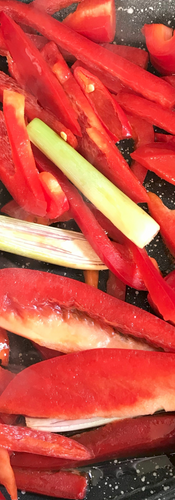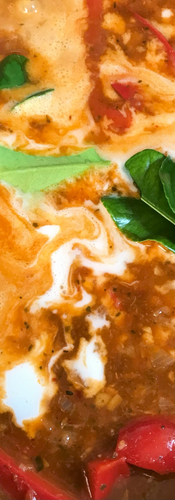Vegan Thai aubergine curry
- Hobbychef
- 3 days ago
- 6 min read
A quick and easy vegan Thai aubergine curry—essentially a classic Thai red curry—is a go-to baseline curry that can be knocked together in no time at all. And, because you can easily add chicken or prawns for dining parties with mixed preferences, this is a light, fresh vegan-first dish that I cook a lot in warmer months.

No egg plant emojis
There's no florid tale behind this vegan Thai aubergine curry, the composite of lessons learned from Thai cooks at home and in Europe. Given the centrality of shrimp paste and fish sauce in much Thai cooking, I had no idea that any such thing as a vegan Thai curry was even possible until my friend Winnie from Phuket revealed that the delicious aubergine red curry she had just fed me was vegan.
"Really? I couldn't tell at all. How did you make the paste? "I asked.
"I didn't make the paste, darling. People who make Thai paste for vegan people make the paste. I just improved on it. Winnie has tricks. I'll show you, darling."
And that was essentially the birth of this recipe; working with tips from Winnie and adjusting to make it work for dining groups from vegan to carnivore at the same table. Winnie's given first name was Mongkol. You can see how boys would be so cruel with that when he was sent to school in England.
After he got into drag as a teenager, he adopted the name Winnie, after his favourite childhood book and his favourite character, Winnie-the-Pooh. But, ever since she taught me tricks with vegan Thai red curry paste, I have always referred to her as Winnie-the-Paste.
I've prepared the carrots using a hand-held spiraliser tool, mainly because it's quicker than finely slicing carrots, but thinly sliced carrots is actually more traditional in this dish.
This version is for 2 to 3 diners, but you can readily do the arithmetic if you want to cater for a larger group. It scales in a a fairly prosaic way; no hidden tricks etc.
3 top tips to get this recipe right: |
|
|
|
Shopping list

for vegan Thai aubergine curry
4 or 5 "baby" aubergines (Thai or otherwise), washed and cut into quarters
3 or 4 sticks of celery, cut into large (3 to 4cm) pieces
Approx.150g readymade vegan Thai red curry paste
500ml vegetable stock; fresh or diluted from a cube/jelly
1 can (400g) coconut milk (full fat)
3 tbspns peanut oil or other vegetable oil
2 sprigs of lemongrass (or 2 tspns bottled minced lemongrass)
3 or 4 shallots (echalion or other large varieties)
Approx. 2 thumbs-lengths of fresh ginger; peeled
Approx. 1 thumb's length fresh galangal; peeled and finely grated (optional)
the zest and juice of 1 fresh lime
4 lime leaves
1 tbspn demerara sugar
2 hot Thai red chillies; sliced vertically and deseeded
I large red bell pepper (or pointed sweet pepper), cut into vertical slices
Approx. 100g fresh mangetout (or sugar snap peas)
1 large carrot (or equivalent) peeled and very thinly sliced
A generous clutch of coriander; roughly chopped
5 or 6 fresh Thai basil leaves
salt and pepper to taste
sides and condiments
Rice — Thai sticky rice, jasmine rice, or Thai black sticky rice
Spicy prawn crackers — a nice extra, but totally optional. I'm partial to the ones made with both tapioca and cassava
Cooking Method
the vegan aubergine Thai curry
Do all your prep first because the cooking moves quickly. Slice the bell pepper, then chop your ginger, galangal and garlic in a mini-chopper or food processer. Mix in the lime zest. Top 'n tail the lemongrass, keeping the most "bulbous" parts intact. Cut into roughly 5cm pieces, Peel off the tough outer layers, slice vertically and crush gently with the blade of a large knife
Heat the oil on a medium high heat in a pot or wok with a lid. Once hot, add the bell pepper, deseeded chillies and lemongrass and stir as it sizzles
When the red pepper shows sign of softening, add the mixed chopped garlic, galangal, shallots and ginger. Stir in and allow to sizzle for a minute or two until the aromas release
Add all the vegan red curry paste at once, stirring in and allowing it to cook. If it sticks, add a dash of the stock. Cook down until almost completely dry without allowing it to stick or burn
Add all of the remaining stock and bring to a healthy simmer. Simmer without covering, stirring occasionally, until it has reduced by approx. half
Add all of the coconut milk at once, and the lime leaves. Stir in, increase the heat slightly and allow to simmer for a few minutes
Add the celery and the aubergines. Stir and simmer vigorously. Add the chopped coriander, cover and reduce the heat slightly, stirring occasionally
Add the lime juice and the sugar, and stir in. Add the chopped coriander and Thai basil leaves and allow to sweat on the surface before stirring in. The aubergine is your guide: it needs to be cooked but not become slimy. When a fork can pass through it with little resistance, add the mangetout and stir in. Cover and simmer for another 3mins or so
If your sauce has suitably reduced (remember that Thai curries aren't meant to be too thick) and the mangetout is "cooked but crunchy", add the carrots. Reduce to a low heat, cover and allow the carrots to marginally cook, for no more that a couple of minutes or so: you want the crunch in this one
Garnish with fresh coriander leaves and serve with rice and side dishes
Alternatives
This is a vegan dish by default that is easily adapted to suit the needs of pescatarians and carnivores, even at the same table. Basically, do the same as hundreds of thousands of Thai street vendors. Either steam or wok your seafood or chicken—in a little lime juice with chopped chillies and a dash of vegan Thai red curry paste—and add into the dish later. I usually decant the portions for vegans, keeping them warm, then add the seafood or chicken into the remaining curry and allow them to soak up the flavours for 2mins, then serve up and keep everyone happy at the same table.
Pairings
Most often I end up pairing this dish with sparkling water and a slice of lime. Nonetheless, like a lot of Thai food, it's great with cold beer.
But, it is a dish that also works well with wine, both reds and whites. With the vegan version, I usually go for red, something not too heavy and overpowering that will fight with the spices such as a pinot noir/Burgundy or Barbera. The wine I think has worked best with it to date is Gianni Doglia Genio Superiore Barbera d'Asti 2021.
Conversely, if I'm doing the seafood or chicken version, I lilt towards a white. Overall, I think South African chenin blancs, Australian chardonnays and Sicilian cattarattos remain the best options with spicy dishes. However, in cooking this dish again to write it up, I was very pleased with a workaday Australian Loved & Found Aranel put out under the UK supermarket chain Waitrose's own brand (no doubt while they could battle down the price on a good wine without market recognition), made with a fairly obscure grape variety, but a crossing of grenache, gris and a distant relative of chardonnay. So you can see how that would work.




























Comments